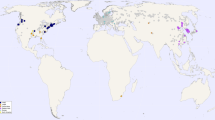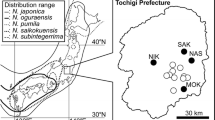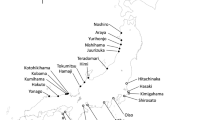Abstract
Nymphoides species are cosmopolitan aquatics with floating leaves and frequent in freshwater wetlands. Nymphoides fallax is restricted to highlands of Mexico and Guatemala. We tested the transferability of 10 microsatellite loci previously developed for N. peltata in 18 populations of N. fallax. Seven polymorphic loci were successfully amplified. Allele sizes were automatically obtained using 2100 Bioanalyzer Expert software. Genotypes were determined using the allele dosage method. Chromosome counts confirmed that N. fallax is a tetraploid. Alleles per locus ranged from 5 to 17; the observed and expected heterozygosities per population ranged from 0.51 to 0.66 and from 0.72 to 0.81, respectively. We observed higher genetic diversity within populations (92%) than among populations (8%). Our results show that cross-amplification is a valid technique for studying Nymphoides. No clones were found, indicating that N. fallax relies heavily on sexual reproduction. Our work may stimulate further population genetic studies of the genus Nymphoides that could be useful for conservation programs, as well as to promote additional research on landscape genetics and reproductive mechanisms in aquatic plants.


Similar content being viewed by others
References
Alix K, Gérard PR, Schwarzacher T, Heslop-Harrison JS (2017) Polyploidy and interspecific hybridization: partners for adaptation, speciation and evolution in plants. Ann Bot 120(2):183–194
Assoumane A, Zoubeirou AM, Rodier-Goud M, Favreau B, Bezançon G, Verhaegen D (2013) Highlighting the occurrence of tetraploidy in Acacia senegal (L.) Willd. and genetic variation patterns in its natural range revealed by DNA microsatellite markers. Tree Genet Genom 9:93–106
Barrett SCH, Shore JS (2008) New insights on heterostyly: comparative biology, ecology and genetics. In: Franklin-Tong VE (ed) Self-incompatibility in flowering plants. Springer, Berlin, pp 3–32
Calhoun AJ, Mushet DM, Bell KP, Boix D, Fitzsimons JA, Isselin-Nondedeu F (2017) Temporary wetlands: challenges and solutions to conserving a ‘disappearing’ ecosystem. Biol Cons. https://doi.org/10.1016/j.biocon.2016.11.024
Cao QJ, Mei FF, Wang L (2017) Population genetic structure in six sympatric and widespread aquatic plants inhabiting diverse lake environments in China. Ecol Evol 7(15):5713–5723
Castro-Castro A, Vargas-Amado G, Castañeda-Nava JJ, Harker M, Munguía-Lino G, Santacruz-Ruvalcaba F, Rodríguez A (2017) Números cromosómicos para tres especies de Cosmos sección Discopoda (Asteraceae, Coreopsideae), con notas citogeográficas. Acta Botánica Mexicana 118:41–51
Cook CD (1990) Seed dispersal of Nymphoides peltata (SG Gmelin) O. Kuntze (Menyanthaceae). Aquat Bot 37(4):325–340
Dufresne F, Stift M, Vergilino R, Mable BK (2014) Recent progress and challenges in population genetics of polyploid organisms: an overview of current state-of-the-art molecular and statistical tools. Mol Ecol 23(1):40–69
Excoffier L, Smouse PE, Quattro JM (1992) Analysis of molecular variance inferred from metric distances among DNA haplotypes: Application to human mitochondrial DNA restriction data. Genetics 131:479–491
Garino C, Rinaldi M, de Paolis A, Travaglia F, Coïsson JD, Arlorio M (2014) Improving the application of SSR polymorphism analysis coupled with Lab-on-a-chip® capillary electrophoresis to assess food authenticity: Italian pigmented rice as case study. Food Res Int 64:790–798. https://doi.org/10.1016/j.foodres.2014.08.008
Grünwald NJ, Goodwin SB, Milgroom MG, Fry WE (2003) Analysis of genotypic diversity data for populations of microorganisms. Phytopathology 93:738–746
Hardy OJ, Vekemans X (2002) SPAGeDi: a versatile computer program to analyse spatial genetic structure at the individual or population levels. Mol Ecol Resour 2(4):618–620. https://doi.org/10.1046/j.1471-8286.2002.00305.x
Hardy O, Vekemans X (2015) SPAGeDi 1.5. A program for Spatial Pattern Analysis of Genetic Diversity. User’s manual. Available via Université Libre de Bruxelles, Brussells, Belgium. https://ebe.ulb.ac.be/ebe/SPAGeDi_files/SPAGeDi_1.5_Manual.pdf. Accessed 27 Feb 2018
Hedrick PW (2011) Genetics of populations, 4th edn. Jones and Bartlett, Boston
Hedrick PW (2013) High inbreeding in sheep or erroneous estimation? J Hered 104(2):298–299
Huang W, Chen Q, Chen K (2015) Seed bank characteristics of the Nymphoides peltata population in Lake Taihu. Scientific Reports. https://doi.org/10.1038/srep13261
Husband BC, Baldwin SJ, Suda J (2013) The incidence of polyploidy in natural plant populations: major patterns and evolutionary processes. In: Greilhuber J, Dolezel J, Wendel J (eds) Plant genome diversity, vol 2. Springer, Vienna, pp 255–276
Kamvar ZN, Tabima JF, Grünwald NJ (2014) Poppr: an R package for genetic analysis of populations with mixed (clonal/sexual) reproduction. PeerJ 2:e281. https://doi.org/10.7717/peerj.281
Kirov I, Divashuk M, Van Laere K, Soloviev A, Khrustaleva L (2014) An easy “SteamDrop” method for high quality plant chromosome preparation. Mol Cytogen. https://doi.org/10.1186/1755-8166-7-21
Landgrave R, Moreno-Casasola P (2012) Evaluación cuantitativa de la pérdida de humedales en México. Investigación Ambiental 4(1):19–35
Larson D (2007) Reproduction strategies in introduced Nymphoides peltata populations revealed by genetic markers. Aquat Bot 86(4):402–406
Li ZZ, Sun SS, Wang QF, Chen JM (2017) RNA-seq analysis of the distylous plant Nymphoides peltata Identified ortholog genes between long-and short-styled flowers. Front in Ecol Evol 5(59):1–3. https://doi.org/10.3389/fevo.2017.00059
Liao YY, Yue XL, Guo YH, Gituru WR, Wang QF, Chen JM (2013) Genotypic diversity and genetic structure of populations of the distylous aquatic plant Nymphoides peltata (Menyanthaceae) in China. J Syst Evol 51(5):536–544. https://doi.org/10.1111/jse.12023
Liu XL, Jiang FF, Wang ZW et al (2017) Wider geographic distribution and higher diversity of hexaploids than tetraploids in Carassius species complex reveal recurrent polyploidy effects on adaptive evolution. Sci Rep. https://doi.org/10.1038/s41598-017-05731-0
Magalhães TL, Martínez M (2018) Temporary freshwater wetlands floristics in central Mexico highlands. Bot Sci 96(1):138–156. https://doi.org/10.17129/botsci.1532
Magallán F, Martínez M, Hernández Sandoval L, Oyama K (2009) Estructura Genética de poblaciones de Eriocaulon bilobatum (Eriocaulaceae): una especie amenazada de humedades temporales. Boletín de la Sociedad Botánica de México 85:81–88
Magallán F, Martínez M, Hernández-Sandoval L, González-Rodríguez A, Oyama K (2013) Diversidad genética de Lilaea scilloides (Juncaginaceae) en el centro de México. Revista Mexicana de Biodiversidad 84(1):240–248
Martínez M, García A (2001) Flora y vegetación acuática de localidades selectas del estado de Querétaro. Acta Botánica Mexicana 54:1–23
Martínez M, Gómez Sánchez M (2006) Descripción anatómica vegetativa de dos especies de Nymphoides (Menyanthaceae). Revista Mexicana de Biodiversidad 77(1):81–87
Meirmans PG, Van Tienderen PH (2013) The effects of inheritance in tetraploids on genetic diversity and population divergence. Heredity 110(2):131–137
Meirmans PG, Den Nijs H, Van Tienderen PH (2006) Male sterility in triploid dandelions: asexual females vs asexual hermaphrodites. Heredity 96:45–52
Moncada P, McCouch S (2004) Simple sequence repeat diversity in diploid and tetraploid Coffea species. Genome 47:501–509
Mora-Olivo A, Villaseñor JL, Martínez M (2013) Las plantas vasculares acuáticas estrictas y su conservación en México. Acta Botánica Mexicana 103:27–63
Morin PA, Manaster C, Mesnick SL, Holland R (2009) Normalization and binning of historical and multi-source microsatellite data: overcoming the problems of allele size shift with allelogram. Molecular Ecology Resources 9(6):1451–1455. https://doi.org/10.1111/j.1755-0998.2009.02672.x
Mushet DM, Calhoun AJ, Alexander LC, Cohen MJ, DeKeyser ES, Fowler L, Lane CR, Lang MW, Rains MC, Walls SC (2015) Geographically isolated wetlands: rethinking a misnomer. Wetlands 35(3):423–431
Nei M (1978) Estimation of average heterozygosity and genetic distance from a small number of individuals. Genetics 89:583–590
Nielsen R, Tarpy DR, Reeve HK (2003) Estimating effective paternity number in social insects and the effective number of alleles in a population. Mol Ecol 12(11):3157–3164. https://doi.org/10.1046/j.1365-294X.2003.01994.x
Nishihiro J, Uesugi R, Takagawa S, Washitani I (2009) Toward the restoration of a sustainable population of a threatened aquatic plant, Nymphoides peltata: Integrated genetic/demographic studies and practices. Biol Cons 142(9):1906–1912
Ornduff R (1969) Neotropical Nymphoides (Menyanthaceae): meso-American and West Indian species. Brittonia 21(4):346–352
Ornduff R (1970) Cytogeography of Nymphoides (Menyanthaceae). Taxon 19(5):715–719. https://doi.org/10.2307/1219284
Pekel JF, Cottam A, Gorelick N, Belward AS (2016) High-resolution mapping of global surface water and its long-term changes. Nature 540:418–422. https://doi.org/10.1038/nature20584
Robertson A, Rich TCG, Allen AM et al (2010) Hybridization and polyploidy as drivers of continuing evolution and speciation in Sorbus. Mol Ecol 19:1675–1690
R Core Team (2017) R: A language and environment for statistical computing. R Foundation for Statistical Computing, Vienna, Austria. Available via https://www.R-project.org/. Accessed 27 Feb 2018
Shibayama Y, Uesugi R, Tsumura Y, Washitani I (2006) Conservation of the Lake Kasumigaura population of Nymphoides indica (L.) Kuntze based on genetic evaluation using microsatellite markers. Limnology 7(3):193–197
Soltis PS, Marchant DB, Van de Peer Y, Soltis DE (2015) Polyploidy and genome evolution in plants. Curr Opin Genet Dev 35:119–125
Sweetman AC, Kettenring KM, Mock KE (2013) The pattern and structure of genetic diversity of Schoenoplectus maritimus: implications for wetland revegetation. Aquat Bot 104:47–54
Takagawa S, Washitani I, Uesugi R, Tsumura Y (2006) Influence of inbreeding depression on a lake population of Nymphoides peltata after restoration from the soil seed bank. Conserv Genet 7(5):705–716
Tani N, Kawahara T, Yoshimaru H (2005) Development and diversity of microsatellite markers for endangered species, Morus boninensis Koidz., to establish conservation program. Mol Ecol Notes 5:398–400
Tani N, Yoshimaru H, Kawahara T, Hoshi Y, Nobushima F, Yasui T (2006) Determination of the genetic structure of remnant Morus boninensis Koidz. trees to establish a conservation program on the Bonin Islands, Japan. BMC Ecol 6(1):14. https://doi.org/10.1186/1472-6785-6-14doi: 10.1186/1472-6785-6-14
Thiers B (2018) Index herbariorum: a global directory of public herbaria and associated staff. new york botanical garden's virtual herbarium. https://sweetgum.nybg.org/science/ih/. Accessed 27 Feb 2018
Tippery NP, Les DH (2011) Phylogenetic relationships and morphological evolution in Nymphoides (Menyanthaceae). Syst Bot 36(4):1101–1113
Tippery NP, Les DH, Padgett DJ, Jacobs SW (2008) Generic circumscription in Menyanthaceae: a phylogenetic evaluation. Syst Bot 33(3):598–612
Tippery NP, Sears NL, Zentner AB, Sivadas V (2018) Evidence for allopolyploid speciation in Nymphoides (Menyanthaceae). Syst Bot 43(1):117–129
Tsuda Y, Semerikov V, Sebastiani F, Vendramin GG, Lascoux M (2017) Multispecies genetic structure and hybridization in the Betula genus across Eurasia. Mol Ecol 26(2):589–605
Uesugi R, Tani N, Goka K, Nishihiro J, Tsumura Y, Washitani I (2005) Isolation and characterization of highly polymorphic microsatellites in the aquatic plant, Nymphoides peltata (Menyanthaceae). Mol Ecol Resour 5(2):343–345
Uesugi R, Nishihiro J, Tsumura Y, Washitani I (2007) Restoration of genetic diversity from soil seed banks in a threatened aquatic plant Nymphoides peltata. Conserv Genet 8(1):111–121
Wang Y, Wang QF, Guo YH, Barrett SC (2005) Reproductive consequences of interactions between clonal growth and sexual reproduction in Nymphoides peltata: a distylous aquatic plant. New Phytol 165(1):329–335. https://doi.org/10.1111/j.1469-8137.2004.01234.x
Acknowledgements
The research was funded by Consejo Nacional de Ciencia y Tecnologia (CONACyT) through the Laboratorio Nacional de Identificación y Caracterización Vegetal (LaniVeg) research grants during 2016 (No. 272045) and 2017 (No. 281478). The first author holds a postgraduate fellowship from CONACyT (No. 590633). Laboratory work was carried out in Molecular and Plant Systematic Laboratory at the University of Guadalajara. We thank Noemi Cobian and Pilar Zamora for assistance with the molecular analysis, Alex Villalvazo for assistance with the chromosomes count, Marcelo Silva, Roberto Vizcaya, Gerardo Guerrero, and Carlos Varela (in memoriam) for field assistance. We appreciate the comments of two anonymous reviewers.
Author information
Authors and Affiliations
Contributions
Conceived and designed the experiments: TLdM DCT MM. Performed the experiments: TLdM. Analyzed the data: TLdM DCT. Wrote the paper: TLdM. Reviewed drafts of the paper: DCT MM.
Corresponding author
Additional information
Handling Editor: Koji TOJO.
Publisher's Note
Springer Nature remains neutral with regard to jurisdictional claims in published maps and institutional affiliations.
Rights and permissions
About this article
Cite this article
Lobato-de Magalhães, T., Cabrera-Toledo, D. & Martínez, M. Microsatellite loci transferability and genetic diversity of the aquatic plant Nymphoides fallax Ornduff (Menyanthaceae), endemic to the Mexican and Guatemalan highlands. Limnology 20, 233–241 (2019). https://doi.org/10.1007/s10201-019-00571-5
Received:
Accepted:
Published:
Issue Date:
DOI: https://doi.org/10.1007/s10201-019-00571-5




